Pros
Cons
Tour & Design
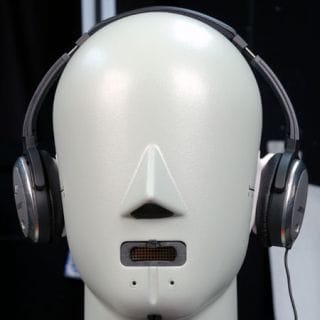
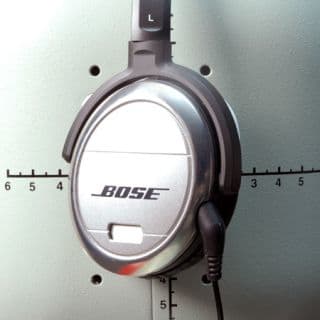
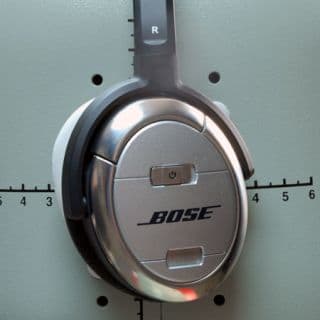
The cups on the Bose QuietComfort 3 headphones are 2.68 inches tall, 2.14 inches wide, and 1.3 inches thick, including the padding. Their backs are silver with black branding, and the back of the right cup has both a slot for a battery pack and a power switch. The back part of the left cup has a bit of a recess where the 2.5mm jack is located. The cups can both twist and tilt. From their storage position, they have about 100 degrees of movement; they can tilt about 45 degrees. The cups are made of black pleather with a cloth center, stretched over a foam pad and plastic framework. These pads can be removed, revealing a metal ribcage and a rather exposed sound element.
The band is a black plastic with a metal interior. The top of the band has a foam pad covered in black cloth on its interior, with padded pleather on its outside edge.
The cord connects to the headphones at their recessed 2.5mm jack. The end that plugs in to the headphones juts out at a 45-degree angle. The other end of the cord is more traditional: it truncates at a 3.5mm plug that has a 90 degree bend in it. The cord itself is about 0.078 inches thick and more than four feet long.
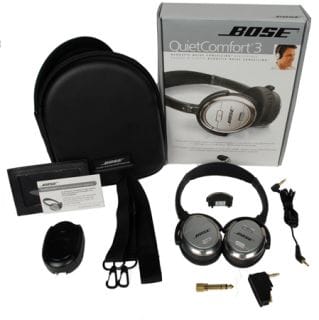
The QC3's box is packed with different items besides the headphones, cord, and battery. First, there's a fairly compact battery charger that resembles a small, non-scented Glade plug-in. Just in case the first cord isn't enough, there's an extension cord which more than doubles your cord length. There are also two plugs: a 3.5mm to 1/4-inch plug and an airplane jack adapter with two 3.5mm jacks. Lastly, it comes with a semi-rigid carrying case (with optional shoulder strap) that the headphones and its accessories fit into.

As an added bonus, inside the case are a few Bose courtesy cards. The cards have pictures of the headphones, Bose branding, and 20 Bose phone numbers on the back. The cards instruct you to hand them out to all who ask about your headphones. This section doesn't receive a score, but if it did we'd take off points for this lame attempt to turn its customers into unpaid solicitors.
We don't see any glaring durability issues on the Bose QuietComfort 3 headphones, though it does have some smaller issues. For one, the band isn't collapsible, which means it runs the risk of being permanently bent if you handle them roughly. It does, however, seem very strong; its metal core has some give to it, but retains its shape very well. The top of the band, like the cups themselves, has some pleather, foam, and cloth in it. While softer, fabric-like parts are more susceptible to wear and tear, we weren't able to easily tear anything on the QC3s.


The cable is made of black plastic and seems durable. We pulled at it pretty hard and it didn't feel as though it was going to break. The plugs have very robust guards that manage to be thick without sacrificing too much flexibility.
Overall, we'd say these headphones are very well manufactured.
Say what you will about Bose, they make some attractive-looking headphones. The metal and plastic design simply looks well built, and the pleather and cloth certainly make the QuietComfort 3 headphones look expensive. They are, like most on-ear headphones, a bit prominent. If you're looking for a discreet listening experience, you should be looking for in-ear buds. If you don't mind wearing stylish ear muffs when you listen to music, however, the Bose QuietComfort 3 headphones are a great head accessory.
Performance
The primary selling point of the Bose QuietComfort 3s is their ability to cancel outside noise, and they do an effective job of this, blocking a lot of outside noise. However, we found their audio quality isn't anything to write home about.
All tests are carried out using a high-end electroacoustic audio analysis system consisting of a Head and Torso Simulator (HATS) and a professional audio analysis program called SoundCheck, produced by Listen, inc. The HATS simulates the human head and ears, and has two microphones in the ears that respond to sounds in the same way your ears do. The Soundcheck system produces a series of test signals and captures the output from the headphones using these microphones, allowing us to do very precise, scientific testing of headphones. For more information on how we do our headphone quality audio testing see this article.
**Frequency Response***(1.66)*
One of the fundamental aspects of performance in headphones is frequency response; how good a job do the headphones do taking the electrical signal the music player produces and turning this into sound? Our testing system analyzes the frequency response by sending a frequency sweep to the headphones that goes from the very low (about 80Hz, which sounds like an earthquake) to the very high (10kHz, which is a high-pitched squeak). How well the headphones reproduce these frequencies is shown on the graph below: low frequencies are on the left, high on the right. The green line is for the left channel, the red is for the right.
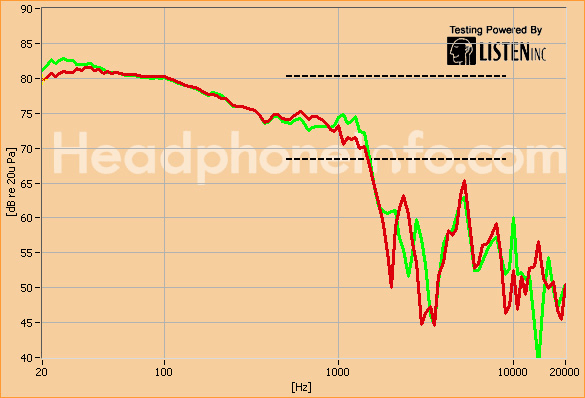
The dotted lines indicate the limits we look for; if anything was to veer too widely above or below these limits, that would indicate the headphones are either overly emphasizing or suppressing those frequencies, which makes the music sound unnatural. The Bose QuietComfort 3 headphones have some problems here; the response curve gets somewhat erratic at the higher end, with sizeable peaks and troughs. This may be a problem for the audio quality; it means two nearby frequencies are reproduced at quite different levels, which wouldn't sound the way it should. We like smooth response curves, but the QuietComfort 3 headphones produces curves that are anything but smooth. However, this erratic response is only a problem at higher frequencies; the curve for the important low frequencies is reasonably smooth, so the big bass frequencies should be clearly reproduced.
It is possible these peaks and troughs could be caused by the active noise cancellation the QuietComfort 3 headphones use; this is generating sounds to cancel noise, so it could be interfering with the music. Since the headphones won't work without noise cancellation turned on, we weren't able to test this theory.
**Distortion***(10.00)
*Distortion is where the headphones don't produce the sound you hope for; the waveform of the sound gets clipped or otherwise mangled by some problem in the drivers that produce the sound. The QuietComfort 3 headphones don't show a huge amout of distortion, but there is some evidence of minor distortion there.
Our system examines the distortion headphones introduce by playing back a frequency sweep of sounds across the frequency range at the typical listening level of around 78 dBSPL and examining the results for any differences from the original waveform. The graph below shows what's called the Total Harmonic Distortion (THD), which is the amount of distortion (as a percentage) of the basic frequency, as well as the higher frequency harmonics that provide the tone and texture of a sound; ideally, these should be reproduced accurately. The graph starts with low, bassy frequencies at the left and goes up to high frequencies at the right. Again, the green line is the left channel and the red line is the right.

Distortion is where the headphones don't produce the sound you hope for - the waveform of the sound gets clipped or otherwise mangled by some sort of a problem in the drivers that produce the sound. The QuietComfort 3 headphones don't show a huge amount of distortion, but there is some evidence of minor distortion at the lower frequencies. But that is a minor problem. On the whole, they have no problem with distortion.
Headphones have one channel for each ear, so it is important that the two sides produce the same sound. That's what we look at in this test - how well balanced the two sides of the headphones are. The QuietComfort 3s had some minor issues here because the balance of sound shifts to a slight degree from side to side.
Our test system produces the graph below, which shows the tracking across the frequency range of 100 to 20kHz. If the line is at 0 percent, that indicates the sound at that frequency is identical in both channels. If it goes above that line, the left channel is stronger, and if it goes below, the right channel is putting out more. The QuietComfort 3s are all over the place at higher frequencies, with the tracking varying wildly from frequency to frequency.
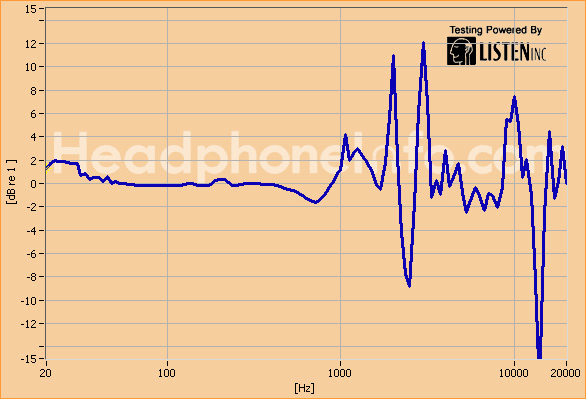
**Maximum Usable Volume (9.65)
**The distortion test we do above is run at a pretty normal listening level of 78 dBSPL, but some people like it loud, so we also test how high we can crank up the volume. We test this by how high we can take the volume until the distortion in the sound reaches 3 percent, where it becomes audible and annoying. The QuietComfort 3s managed to reach an ear-splitting118.5 dBSPL before our testing system called a halt to the test; that's loud enough that even the most avid loud music fans can enjoy distortion-free tunes. Unless they are into grunge music or heavy metal, where the distortion is built in. And remember, our testing system has replaceable ears - yours are not. If you crank the volume up that high, you're likely to permanently damage them.
Isolation is one of the big selling points of the QuietComfort 3 headphones; Bose claims its active noise-cancelling circuitry identifies and cancels noise, and our tests show these headphones do a very good job of this.
The graph below shows the frequency range of 20Hz to 20kHz, with the line indicating how much sound is blocked at that frequency; higher is better. The green line is for with the headphones in place, but with the sound-cancelling turned off. The blue line is for the same test, but with the noise-cancelling enabled. In both cases, the higher the line, the more noise the headphones block.
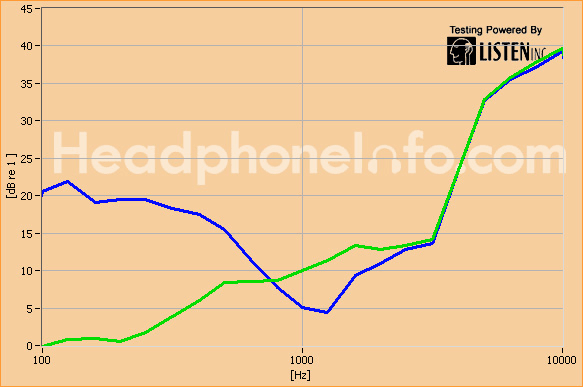
As you can see, the active noise cancelling does a much more effective job, especially at lower frequencies. With these low frequency noises (such as you would get inside an airplane in flight), the headphones turned off don't block anything, and low frequency rumbles go straight through them. But with the noise cancelling turned on, a significant amount of these noises are blocked. Over the entire frequency range, they block an average of about 15 dB of noise. But like the QuietComfort 2s, there is an odd spot in the middle where the headphones block more sound with the noise cancellation turned off than with it turned on, possibly because of a quirk of the noise cancelling system.
It is also interesting to compare the effectiveness of these against another type of headphones, the in-ear ear canal ones like the Etymotic ER6i and Shure SE210. Both blocked more overall noise than the QuietComfort 3 headphones because they effectively act as earplugs, blocking the ear canal with an average reduction of about 30dB. They do a more effective job than both the QuietComfort 3 and their sibling QuietComfort 2s, but many people don't like putting things in their ears. For these people, the QuietComfort 3 headphones do an effective job blocking unwanted sounds.
The QuietComfort 3 headphones also do only a middling job protecting the outside world from you; in our tests, we found some sound escapes from the headphones that might bother someone sitting close to you; in a quiet room you can hear the music from several feet away. That's because the on-ear design does not form a perfect seal, so there is always a gap that lets some noise through.
In Use
Summary
The Bose QuietComfort3 headphones are comfortable. They have foam padding on the ear cups and the band, which is covered with a soft faux-leather material. As on-ear headphones without a collapsible band, these headphones aren't very portable. Fortunately, their ear cups can be rotated to help the headphones lie flat. Also, the case certainly helps keep everything together. Unfortunately, the case itself is rather large. In terms of customizability, the QC3s don't offer many options.
There aren't many customization options that come in the Bose QuietComfort 3's box, such as different ear cups. That being said, to get comfortable all we had to do was fiddle with the band setting until it fit our noggin snugly.


We think the QC3s are very comfortable. The padded band keeps the hard plastic off our head, and the padded ear cups don't put much pressure at all on our ears. As with all larger-sized on-ear or over-ear headphones, moving your head around causes them to slip. We wouldn't recommend using these as workout headphones.
The only comfort issue users should look out for is the noise cancelling feature. If you're not used to this feature, it'll certainly be a weird sensation. After wearing it for a few minutes you might feel like you need to pop your ears. The worst part is you can't disable noise cancellation, so you'll just have to deal with the discomfort until you get used to it or send the headphones back for a refund.
Good on-ear and over-ear headphones tend to be comfortable for extended use, because there is no pressure on the inside of your ear canal. The cup padding and its covering are soft enough to not even cause mild trauma to your ears. The benefit of wearing them for a while is that you'll get used to the noise cancelling (if you aren't already). And they might slide off if you're an invetres head-jiggler who likes to nod along to the music.

The cable is a good thickness, measuring 0.078 inches in diameter. Its coating feels fairly robust, but like most plastic wire coating it might pick up cuts easily. The cable holds a bit of a shape, but you'll never have to worry about it getting wrinkled into knots.
The cord is more than four feet: a good length. In case this isn't long enough, an extension cord is also included.

Since the headphones have a 2.5mm jack, replacing the included cable might be difficult. Also, the 3.5mm plug at the other end has a thick casing around it. This means the plug might easily slip out of devices with recessed jacks, like the iPhone, because the plug can't fit far enough into the jack to catch.
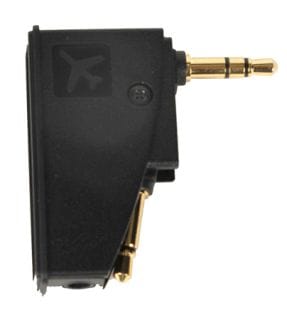

There is also an included airplane adapter, which is built to conform to the double jacks on airplane arm rests.



The Bose QuietComfort3s aren't the most portable headphones out there, but they are better off than many on-ear headphones. For one, the cups can rotate so the headphones can lie relatively flat. Also, the QC3s come with a semi-rigid case that holds them and all their accessories tightly. The case is pretty big, however, and it'll definitely take up a lot of room in your bag.

If you want, you could use the courtesy card holder as a wallet.

The QC3s can twist around within a 100-degree arc, and have a 45-degree range of motion for tilting. This is a relatively small range of motion, but should be more than enough to conform to your head. The box also contains three different adapters to plug the cord into: a 3.5mm to 1/4-inch plug adapter, an airplane jack adapter, and an extension cord. There aren't any additional cups included, or any face plates or color options. Still, the Bose QuietComfort 3 headphones come with more options than the average set of headphones.


Cleaning these headphones seems to be easy. Once you've snapped off the ear cups - which is very easy to do - everything is basically exposed. The downside to this is that you run a higher risk of damaging the sound element when you clean. There aren't any included cleaning instruments or replacement parts. Fortunately, since you can disconnect the cups, you will be able to find replacements, though the cloth on the band is stuck there, meaning it'll be very hard to clean or replace. Overall, however, these headphones should be relatively easy to clean and maintain.
*Battery Dependency
*
In a stunning display of poor design, the Bose QuietComfort 3 headphones won't work without a battery. This is simply absurd, and drastically limits their functionality; if the battery runs out halfway through a flight, you'll be stuck flicking peanuts at your neighbors for amusement while they enjoy the in-flight movie or music on their cheaper (but still usable) headphones.




Noise Cancelling
This score accounts for anything interesting functionality the noise cancellation feature adds to the headphones above and beyond isolation (which, of course we score). In the case of the Bost QuietComfort 3 headphones, there is no 'above and beyond,' just 'won't work without': music playback is totally dependent on whether noise cancellation is powered on. This, to put it simply, is stupid, because it means the headphones won't function as headphones without a battery. If you run out of battery life, the Bose QC3s just become an expensive pair of ear muffs, which are attached to your media player with a leash. Unfortunately, this is the status quo for most noise cancelling headphones. If you want to see more robust noise cancellation, check out the
, which let you choose from a few different cancellation curves, and the
, which will let you turn off your headphones.
Value & Comparisons
The Bose QuietComfort3 headphones provide all the aesthetic flair of their predecessors, but are far more compact. The general public - especially business professionals - would probably prefer the QC3s to the QC2s since they're less bulky, less obvious, and have slightly better audio quality. Dollars to doughnuts, however, the QC3s just don't offer enough in the way of actual functionality to add up to their $350 ticket price.
The true selling point of these headphones isn't their actual performance, however, it's their appearance. Unfortunately, this is all subjective territory, so personal preference will factor highly in the final decision. If you're not an audiophile and want something pretty, you could do a lot worse than the QC3s.
Conclusion
Audiophile
Audiophiles that don't instinctively scoff at the branding will find the sound quality lacking.
Portable User
Portable users will find these headphones a bit of a burden, both in terms of size and in terms of the restrictions the battery dependency creates. If the headphones stop working after a few hours away from a socket, they really aren't that portable.
Airplane Traveler
While the noise cancellation should help you get to sleep, the limited battery life will only be able to keep you entertained for short flights.
Home / Office Use
The QC3s are indigenous to a home/office environment, where sockets for recharging its battery are plentiful. They will help those who wish to watch TV without disturbing roommates. The cable might be a bit too short to stretch across a room, so you might need to invest in an extension.
The Bose QuietComfort3 headphones are hard to review objectively. They don't offer stellar audio quality by any means. In terms of usability, they are comfortable, but the battery dependency inhibits their functionality. We do recognize that these headphones are good looking, but only the buyer can assign a value to aesthetics.
Therefore, if you're looking for a flashy headpiece you can take to the office and like being able to casually discuss its 'active noise cancellation' feature, then you should at least consider these headphones. If looks play a very minor role in your decisionmaking, we really can't recommend the QuietComfort 3s.
Meet the tester
Mark Brezinski works on the Home Team, reviewing refrigerators, minifridges, dishwashers, washing machines, dryers, air conditioners, air purifiers, and fans.
Checking our work.
Our team is here to help you buy the best stuff and love what you own. Our writers, editors, and experts obsess over the products we cover to make sure you're confident and satisfied. Have a different opinion about something we recommend? Email us and we'll compare notes.
Shoot us an email